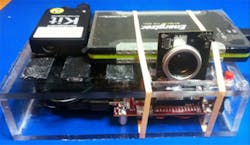How to build your own 3-D camera
If you are interested in developing your own 3-D camera based on the principle of structured light, then look no further than The Hackengineer web site, which plans to provide a blow by blow account of how to do so.
Structured lighting techniques use a set of images that are sequentially projected onto a scene that are then captured with an ordinary CMOS camera. The deformation of the structured light is run though an algorithm to determine the depth at each pixel. The resulting x,y, and z coordinates (3-D point cloud) can then be used to reproduce a 3-D model of a scene.
In the first of the posts on the The Hackengineer web site, the hardware of the system is described in some detail. The system itself uses a Texas Instruments (Dallas, TX, USA) DLP pico projector, Leopard Imaging’s (Milpitas, CA, USA) Leopardboard 365 VGA camera board, a small 2x telephoto lens, and a BeagleBoard from BeagleBoard.org -- an all volunteer activity started up by a collection of Texas Instruments’ employees, amongst others.
As the site shows, the results are fairly impressive for a completely portable setup -- especially considering the price of the system.
More information can be found here.
-- Dave Wilson, Senior Editor, Vision Systems Design
